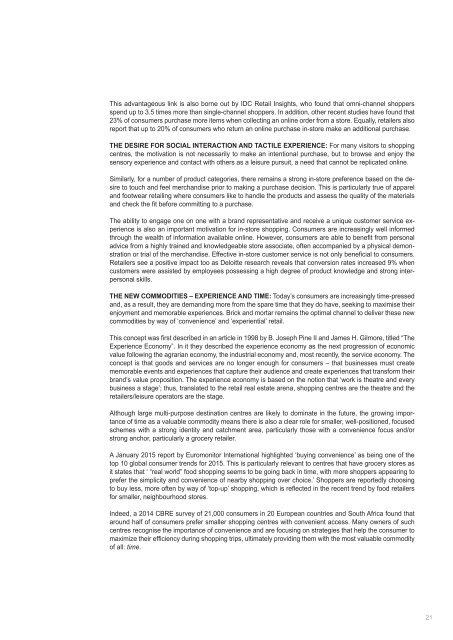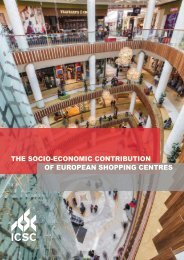THE SOCIO-ECONOMIC CONTRIBUTION OF EUROPEAN SHOPPING CENTRES
You also want an ePaper? Increase the reach of your titles
YUMPU automatically turns print PDFs into web optimized ePapers that Google loves.
This advantageous link is also borne out by IDC Retail Insights, who found that omni-channel shoppers<br />
spend up to 3.5 times more than single-channel shoppers. In addition, other recent studies have found that<br />
23% of consumers purchase more items when collecting an online order from a store. Equally, retailers also<br />
report that up to 20% of consumers who return an online purchase in-store make an additional purchase.<br />
<strong>THE</strong> DESIRE FOR SOCIAL INTERACTION AND TACTILE EXPERIENCE: For many visitors to shopping<br />
centres, the motivation is not necessarily to make an intentional purchase, but to browse and enjoy the<br />
sensory experience and contact with others as a leisure pursuit, a need that cannot be replicated online.<br />
Similarly, for a number of product categories, there remains a strong in-store preference based on the desire<br />
to touch and feel merchandise prior to making a purchase decision. This is particularly true of apparel<br />
and footwear retailing where consumers like to handle the products and assess the quality of the materials<br />
and check the fit before committing to a purchase.<br />
The ability to engage one on one with a brand representative and receive a unique customer service experience<br />
is also an important motivation for in-store shopping. Consumers are increasingly well informed<br />
through the wealth of information available online. However, consumers are able to benefit from personal<br />
advice from a highly trained and knowledgeable store associate, often accompanied by a physical demonstration<br />
or trial of the merchandise. Effective in-store customer service is not only beneficial to consumers.<br />
Retailers see a positive impact too as Deloitte research reveals that conversion rates increased 9% when<br />
customers were assisted by employees possessing a high degree of product knowledge and strong interpersonal<br />
skills.<br />
<strong>THE</strong> NEW COMMODITIES – EXPERIENCE AND TIME: Today’s consumers are increasingly time-pressed<br />
and, as a result, they are demanding more from the spare time that they do have, seeking to maximise their<br />
enjoyment and memorable experiences. Brick and mortar remains the optimal channel to deliver these new<br />
commodities by way of ‘convenience’ and ‘experiential’ retail.<br />
This concept was first described in an article in 1998 by B. Joseph Pine II and James H. Gilmore, titled “The<br />
Experience Economy”. In it they described the experience economy as the next progression of economic<br />
value following the agrarian economy, the industrial economy and, most recently, the service economy. The<br />
concept is that goods and services are no longer enough for consumers – that businesses must create<br />
memorable events and experiences that capture their audience and create experiences that transform their<br />
brand’s value proposition. The experience economy is based on the notion that ‘work is theatre and every<br />
business a stage’; thus, translated to the retail real estate arena, shopping centres are the theatre and the<br />
retailers/leisure operators are the stage.<br />
Although large multi-purpose destination centres are likely to dominate in the future, the growing importance<br />
of time as a valuable commodity means there is also a clear role for smaller, well-positioned, focused<br />
schemes with a strong identity and catchment area, particularly those with a convenience focus and/or<br />
strong anchor, particularly a grocery retailer.<br />
A January 2015 report by Euromonitor International highlighted ‘buying convenience’ as being one of the<br />
top 10 global consumer trends for 2015. This is particularly relevant to centres that have grocery stores as<br />
it states that ‘ “real world” food shopping seems to be going back in time, with more shoppers appearing to<br />
prefer the simplicity and convenience of nearby shopping over choice.’ Shoppers are reportedly choosing<br />
to buy less, more often by way of ‘top-up’ shopping, which is reflected in the recent trend by food retailers<br />
for smaller, neighbourhood stores.<br />
Indeed, a 2014 CBRE survey of 21,000 consumers in 20 European countries and South Africa found that<br />
around half of consumers prefer smaller shopping centres with convenient access. Many owners of such<br />
centres recognise the importance of convenience and are focusing on strategies that help the consumer to<br />
maximize their efficiency during shopping trips, ultimately providing them with the most valuable commodity<br />
of all: time.<br />
21



